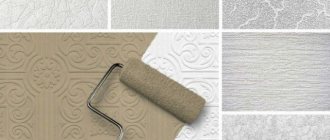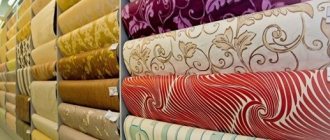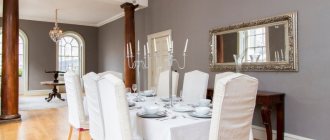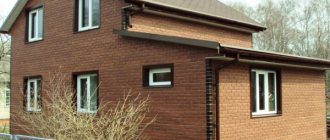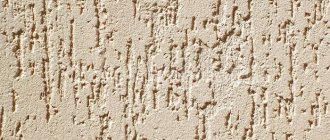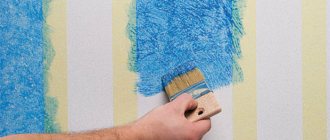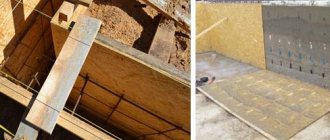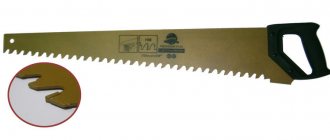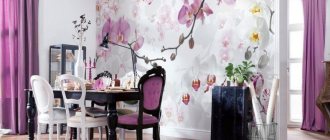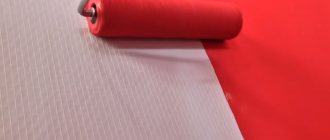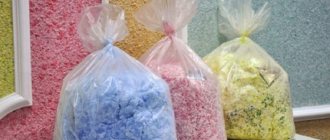Types of wallpaper that can be painted
On an unpasted wall, if it is painted, defects will appear over time. Decorating walls with wallpaper allows you to avoid this. Moreover, if you hang wallpaper and then paint it in the desired color, this can mask all the flaws and surface defects.
Tip 2 – The color will look richer on a papered wall.
Thanks to the relief structure, wallpaper is able to convey shades better. It is also very convenient to paste over uneven walls with relief materials. If you paint a wall without wallpapering, then it will be impossible to hide the unevenness; even the smallest grains of dust can be noticeable.
More details about the types of trellises are written in the article on how to hang wallpaper on the ceiling yourself. Now we will only list their main types:
- paper;
- vinyl;
- non-woven;
- liquid;
- glass wallpaper.
Carry out the gluing correctly; to do this, read the article on how to hang wallpaper yourself.
Painting effect
The final result largely depends on the coloring composition. And what’s interesting is that the wall can be repainted a different color over time. The better the base, the more times you can repaint the wall.
Tip 3 – even simple paper wallpaper can be painted up to 5 times. Vinyl can be repainted up to 10 times. You can change the color of non-woven wallpaper 10-15 times. The liquid type cannot be repainted to a different color, unless you can change the shade. Fiberglass wallpaper is suitable for repeated repainting.
Also, the number of repaintings depends on the composition. There are paint and varnish compositions that, after drying, form a film on the surface, which prevents the wallpaper from breathing. Due to the formation of the film, fungus may develop, and the wallpaper may become deformed. If you are struggling with mold, be sure to read the article on how to get rid of fungus on the wall in an apartment.
Drawings and decoration
After the first layer of paint has dried, you can begin to decorate the ceiling or walls by creating certain applications, ornaments and designs on their surface.
This stage should be planned before the renovation and purchase of wallpaper begins. Indeed, today such finishing has a wide range of products, differing in texture, patterns and other characteristics.
When creating drawings with other types of paint, you can use a hard roller and wallpaper with a pronounced relief. Thus, you can paint your wallpaper with your own hands with water-based paint of a different color and get a beautiful and unusual design. In addition, to obtain certain artistic effects, you can use the following tools:
- brushes of different sizes;
- stencils;
- cotton swabs.
Article on the topic: Liquid wallpaper, how to apply it to the wall: video, on walls, applying it yourself, what is it, at home on drywall, on old ones, photos
Thanks to such tools, a person will be able to create even a complex floral ornament with his own hands.
Decor and designs are applied with dyes of other colors that contrast with the primary layer. It is desirable that the dye chosen in this situation has certain properties (for example, moisture resistance, mechanical resistance, etc.). For these purposes, there are a wide variety of special artistic compositions. But their cost is quite high. Therefore, they are usually used by professionals who have the necessary skills and knowledge.
If the paint does not have additional properties, after it has dried, the surface of the walls and ceiling can be varnished for a longer service life.
The key to successfully applying decor with water-based paint is correctly selected materials with compatible components. Using such materials, even a beginner can achieve excellent results and high quality of work done with their own hands.
Which paint is better
The most popular types of paints, top varieties:
- With acrylic composition.
- Water-based.
- Latex.
The acrylic variety is considered the most popular. The use of acrylic composition allows you to achieve high strength and moisture resistance. And due to the variety of color shades, you can experiment and implement interesting design solutions. Some compositions emit harmful chemicals when evaporating - this is not about acrylic. This is a completely harmless substance suitable for painting wallpaper.
After painting with acrylic composition, the surface can be washed. Due to the moisture-repellent properties of acrylic, it can be used to paint walls in apartments with high humidity. But when painting paper wallpaper with acrylic paint, the canvas becomes significantly heavier. Because of this factor, the number of possible repaintings of paper trellises is reduced.
Tip 4 - If you want the most affordable option, choose a water-based composition.
But water-based emulsion has a number of disadvantages compared to traditional types of paint. Among them:
- fragility;
- washes off with water;
- fades in the sun.
Water-based compositions are more suitable for finishing the ceiling. If it is applied to wallpaper, then most often it is applied to paper. Also, water-based emulsion is used to cover the surface treated with decorative plaster.
Latex paint is considered to be of the highest quality compared to other varieties. High moisture-resistant properties, absence of harmful substances, high-quality structure - all this makes latex one of the best. But the price of latex composition is higher. One of the relative disadvantages is the lack of color saturation. Latex will help achieve soft color shades.
The latex composition should be applied in a thin layer as quickly as possible. The fact is that latex dries very quickly, which limits the time it can be applied to the surface. If you delay, smudges and noticeable transitions will form. The dried coating easily allows air to pass through. Strength is determined by the degree of gloss in the composition.
How to apply the first layer
In the painting process, the most difficult moment for beginners who will do this with their own hands is applying the primary layer. The final result and the final appearance of the walls or ceiling depend on how well the first layer is applied.
But before considering the features of applying water-based paint yourself, it should be noted that the base for the paint must be special. The following paintable wallpapers are suitable for these purposes:
- vinyl;
- non-woven;
- glass wallpaper.
Some people wonder “is it possible to paint liquid wallpaper?” This question arose from the specificity that liquid wallpaper has. Once applied to the surface, liquid wallpaper allows you to create a layer of finish that is pleasant to the touch. But it will be lost if the liquid wallpaper is painted. Therefore, if you decide to paint liquid wallpaper, weigh the pros and cons. Experts recommend using the above-mentioned materials rather than liquid wallpaper as a base for paint.
Typically, paint is applied to a base such as wallpaper (special or liquid) in several layers. The main thing here is to apply the first layer correctly, and the rest will go on without problems. The technology of applying paint in several layers allows you to obtain certain patterns and designs on the ceiling or walls. Moreover, if you master this technology correctly, you can achieve an unusual result, even without being an artist.
To apply the first coat of paint, special preparation must be carried out. It involves sealing all places that should not be touched by paint with special masking tape. In addition, the entire work surface on the ceiling or walls must be cleaned of dust and dirt. For these purposes, use a damp cloth.
Related article: Overlays for metal doors
Also, before painting, you need to purchase water-based paint with pigment. It is necessary to calculate the consumption of coloring material per 1 m2 of surface. This is necessary in order to immediately prepare the required volume of the mixture and so that it has the same color. This is the only way to achieve a uniform shade over the entire surface of the ceiling and walls.
After the preparation has been completed, you can begin to apply the primary layer yourself. In this situation, the algorithm of actions taken is as follows:
- First, a little dye should be applied to a section of the wall or ceiling. This area should be the least noticeable. This way you can visually evaluate the final result and the correctness of the selected proportions used to prepare the dye.
- If you are satisfied with the result, painting the remaining areas on the ceiling or walls should be done using a soft roller.
- The first layer is applied in one direction, and all subsequent layers in another.
After this, when the first thin layer of paint has been applied to the prepared surface, it must be given time to dry completely.
Remember that after painting walls or ceilings with water-based paint, it will be quite problematic to stick wallpaper on them. Therefore, if you are planning an application, the place where it will be applied must be covered with masking tape before painting.
TOP manufacturers
When choosing paint, you should understand that you can buy samples from different price segments. One price category has its own product leaders.
Budget options:
- Maestro Acomix. Marshall paint and varnish products are low priced and extremely popular. The dried composition can be wiped with a damp cloth/rag. But he is afraid of direct exposure to water. Suitable for areas with heavy dirt.
- Finncolor, manufacturer – Tikkurila. Can be used in damp areas. Wear-resistant paint that protects the surface from the formation of fungus and mold.
Samples from the middle price segment:
- Belinka. Coloring occurs on a tone-on-tone basis. Interior paint with high durability, the surface can be washed after painting, the composition resists dirt well. But it has a sharp, concentrated odor, which must be taken into account when repairing.
- Alpina. It has a high degree of strength and effectively resists fading in the sun. The surface can be washed after painting and drying. But consumption may be increased.
- Dufa. Waterproof paint, resists abrasions well, has a variety of textures. Some varieties contain silver ions. This helps increase bactericidal properties.
Dear analogues:
- Dulux. Can be used in damp areas such as kitchens and bathrooms. Rich color, deep structure. Easy to apply, wipe-resistant.
- Beckers. Safe paint and varnish products, resistant to abrasion, demonstrate high moisture-resistant properties.
What are the advantages of wallpaper for painting?
- Quality. In order for painting the wallpaper to look like it was done by professionals, no particularly careful preparation of the walls and their alignment are required.
- Individuality. There is confidence that no one else has such wallpaper except you.
- Easy to paint. Even a beginner in the repair business can cope with staining.
- Practicality. You can repaint the wallpaper up to 8-10 times, avoiding re-gluing and all of the above types of work.
- Water resistance. After painting, wallpaper can be safely cleaned with wet water.
- Wear resistance. Wallpaper is not very susceptible to mechanical damage and fading in the sun.
Paintable wallpaper can be made using any of the technologies described above. However, paper ones, despite their cheapness, are not worth purchasing, since they are unlikely to be repainted more than twice. Smooth and hard vinyl is also not recommended for painting. The best option in this case is non-woven wallpaper and foam vinyl wallpaper.
Both options are easy to paint due to the presence of a porous structure and will look very advantageous due to their pronounced relief.
The best color - how to make a difficult choice
Tip 5 – Use computer coloring. This will help you understand which color is best to use.
Initially, wallpaper paint is white. To give a particular shade, a coloring pigment is added. So you can make the same paint in any color. To obtain a homogeneous mixture, the pigment should be stirred well.
When mixing the pigment with the base, the following difficulties may arise:
- The paint is difficult to stir by hand. By making two batches with the same proportions, different color shades are obtained. Even after calculating the required amount of dye pigment, it is quite difficult to get the same color as last time.
- By mixing several dyes together, it becomes even more difficult to obtain the same colors.
Computer coloring is done using special equipment. There are millions of tones and shades. And each of them is assigned a number: a unique color identifier. By specifying the color code, the program will calculate how much color pigment is needed for mixing. Moreover, almost any volume can be mixed efficiently.
In this case, you can afford to buy less paint, and subsequently buy more. Using equipment, the program will mix the right amount of paint in the right proportions.
Interior Design Ideas
The color scheme should be selected individually. But it still doesn’t hurt to follow the rules for placing objects and colors:
- Small rooms should use a light color palette. Beige colors fit perfectly into the interior. Pastel colors will always be a current trend.
- In a north facing room, use yellow as the main color.
- In addition to the main color, additional shades can be used. Such accents can be easily created using graphite paint.
- Coloring compositions are divided by type into matte and glossy. A matte surface with glossy inclusions will enhance the visual effect.
- The gradient will look interesting.
For more ideas on interior design, read the article on how to properly arrange furniture in a room.
How to accurately calculate consumption
Tip 6 – Calculate in meters. Measure the length, width, height of the room with a tape measure. Subtract the area of windows, doors and other unpainted surfaces.
It is very easy to make a mistake when calculating paint. To do everything correctly, make adjustments to the quality of the surface that is being painted. During the preparatory stage, violations must be avoided. When the technology is not broken, then less paint is consumed. If the surface is poorly prepared, more layers and more composition may be required per layer. Therefore, in the desire to save money, you need to show moderation so as not to achieve the exact opposite effect.
For different manufacturers, the consumption of dye per 1 square meter differs. In addition to the information on the can, the same information can be found on the manufacturer’s official website. To quickly calculate how much paint is needed, we recommend using a calculator specially created for this purpose.
Time for complete drying - how long to wait
Tip 7 – Apply a second coat only after the first has completely dried. Wait at least 12 hours.
What affects drying speed:
- Porosity.
- Temperature.
- Humidity.
- Ventilation.
- Layer thickness.
The higher the porosity of the surface, the longer it takes for the layer to dry. The composition applied to a non-wallpapered surface dries faster.
It is important to observe the temperature regime. At too high temperatures, the paint composition becomes insufficiently thick. See instructions on the can.
Fresh air must enter the apartment. But it is recommended to prevent any drafts.
What type of wallpaper is best suited for painting?
Answering the question: what kind of wallpaper is painted, we note that it is better to forget about transforming paper wallpaper using coloring. They are very soft and thin. The paper may soften from the paint and begin to bubble, then drying out in unsightly lumps. In addition, careless movement with a brush or roller can tear or crumple the material, and you can’t even dream about the aesthetics of such a repair.
Vinyl, on the contrary, due to its dense structure, in most cases is not painted over. Dye can collect in certain areas, forming pigment islands. Before starting work, you should experiment on a small area of wallpaper and only after complete drying decide whether you need to continue painting.
Finally, non-woven wallpaper is simply created for repeated painting procedures. All their characteristics: composition, relief, strength, density, but at the same time the lightness and porosity of the material indicate that the paint will lie smoothly and evenly on the non-woven fabric.
If you are going to paint already pasted wallpaper, you should start from an inconspicuous corner of the room so that the wallpaper does not have to be changed. If you want to completely update the renovation, it is recommended to purchase special wallpaper for painting.
What to do if the paint crumbles and why this happens
Tip 8 - To never make a mistake, study the reasons why the layer begins to peel and crumble.
The main causes of shedding:
- Relative humidity requirements are not met.
- Different types of coloring composition are used.
- The dyeing technology is broken.
If the applied layer crumbles, most likely one of these points is not in order.
Preparation of materials and surface
Some experts at the preparation stage advise applying a primer to the canvas to ensure better distribution of paint over the finishing surface and prevent the formation of stains. Typically, paint stains appear due to uneven saturation of the finishing surface. But in this situation, when using special wallpaper and water-based paint, the use of a primer is not a prerequisite. In addition, the finish itself already has high adhesion, which does not need to be increased further.
Related article: How to choose a roulette?
You also need to carry out the following manipulations:
- de-energize the room to prevent short circuits and accidents;
- the temperature regime of the room must meet the requirements of the dye application technology;
- close all windows and doors to prevent the risk of drafts (this will ensure even drying of painted surfaces);
- cover the floor, doors and windows with covering material.
In addition, you will need the following materials:
- different types of rollers for applying the primary layer and patterns;
- tassels;
- tray;
- masking tape;
- ladder.
It would be a good idea to use protective clothing (gloves, hats, goggles) while working.
Is it worth repainting?
Tip 9 – Follow the manufacturer's instructions. This is almost the only way to paint wallpaper correctly.
Definitely paintable wallpaper is primarily intended for painting, including many times. The main advantage is that you can quickly change the color of the walls if you wish. Depending on the thickness of the layers applied and the type of wallpaper, walls can be repainted on average 5-10 times.
Moreover, after the 5th repainting you need to be prepared for the relief of the drawing to be lost in the layers. With each new layer, the relief will only decrease or will not be visible at all.
Stages of work
Let's take a brief look at the main types of work that you will have to do to paint paper-based wallpaper.
Necessary preparation
So, preparatory work represents the first stage, the quality of which determines how successful the entire repair will be. Brush dust, remove dirt and vacuum the room. Cover the baseboards and other protruding interior parts (film or masking tape is suitable for this). A water-repellent coating can then be applied. Only after this protective layer has completely dried, which takes at least 24 hours, can you begin to prepare the paint.
Attention! In order to subsequently avoid lengthy cleaning, it is advisable to cover the entire surface of the floor with film or, as a last resort, newspapers.
Preparing the paint
So, above we looked at what kind of paint can be used to paint paper wallpaper for painting. Preparing the coloring composition is not difficult. To do this, just open a can of paint and mix everything thoroughly. If there is a need and the design of the room requires it, you can mix a color scheme.
Painting the walls: instructions
The preparatory work has been completed, the coloring composition is ready, and now we can move on to the main stage: painting. Here's a quick guide:
- So, direct application is done using a roller. As for corners, as well as hard-to-reach places, use brushes of different sizes.
- First of all, repaint those areas of the walls that will subsequently be covered with pieces of furniture, as this will help “get your hand.”
- It is best to start by painting the ceiling (if provided for by the project) or the upper part of the walls.
- After applying two layers of paint (you need to leave a few hours between them to dry completely), make sure that the surface is smooth and the layer is uniform. That's it, the repainting can be considered complete.
Be sure to watch the video instructions for proper painting:
Choosing paint - recommendations from the seller
Tip 10 – It’s difficult to paint a dark surface with light paint. It is not recommended to paint over bright or dark surfaces.
The answer to the question of which paint is best for wallpaper for painting will be any that fits into the overall concept and at the same time will withstand room temperature and humidity.
Recommendations from the seller:
- Prepare the surface thoroughly.
- Consider environmental indicators.
- Remember that the dry layer will change tone slightly.
- Use professional tools for work.
- Follow the technology for correctly applying paint to wallpaper.
- Choose paint and varnish products from well-known manufacturers.
- Use calculations.
When painting, it is important to be clean and neat.
Treat with PVA glue
Let's take a closer look at the technology of applying PVA glue as a primer on all walls covered with paper wallpaper. If you have started a major renovation and you need to varnish the walls in all rooms, then it turns out to be quite expensive. A more economical option is to prepare an emulsion from glue, in particular construction PVA.
Make the solution as follows: take 1 liter of PVA glue for 10 liters of clean cold water. Then the composition is mixed well. The resulting emulsion should be used to cover the paper covering on the walls. For convenience, take a large brush and, starting from the top, move down, evenly applying the emulsion.
To apply to the walls you will need a large amount of glue
Some owners also apply acrylic varnish after this coating. It is not necessary to do this immediately during a major overhaul; you can paint it later, after a while.
If you are afraid of ruining something, test the mixture on a small area, then wait until the composition dries and evaluate the result. If you are satisfied with the result, then treat all the walls this way. Now they are protected from dirt and you don’t have to worry about accidentally touching the wallpaper with greasy fingers. It will be enough to wipe the area with a soapy sponge to remove dirt.
These simple methods make it easy to keep the decorative coating of paper wallpaper in good condition for a long time. If you don’t like difficulties, buy durable and wear-resistant vinyl analogues.
There are several different types of wallpaper that can be painted, including paper ones. Paper wallpapers are not the most durable of those available today. Over time, they fade, fade from exposure to sunlight, and become dirty. Unlike thick, light-resistant and water-resistant vinyl or non-woven wallpaper, paper wallpaper cannot be wiped with a damp cloth or otherwise refreshed. If you have paper wallpaper specifically designed for painting or paper-based vinyl wallpaper, then there is no problem. They can simply be repainted. However, if you had ordinary paper wallpaper and for some reason you don’t want to change this wallpaper, then there is still a way to give it a new life. Any paper wallpaper can also be painted. It is true that ordinary paper wallpaper cannot be painted several times, since such wallpaper is too thin and not very dense, but it can be done at least once. To do everything right, with your own hands, you don’t need much. What needs to be done for this and how will be discussed further.
